Ancestry just did a major update to its ancestry composition estimates based on DNA tests. I was sad to see that my brother and I lost all our German. That seems strange and incorrect, as our grandmother was Bavarian. Now her ethnicity appears to be some combination of Swedish, English, Norwegian, and Eastern European. Germany was a crossroads between Eastern, Western, and Northern Europe so one expects to be very mixed, still I was sorry to see her German and Italian go away. On the other hand, I am pleased to now be 49% Norwegian since my father was the son of Norwegian immigrants in Brooklyn and I am also happy to be even more Jewish.
The ethnicity comparison with my first cousin who shares my German grandparents (one Jewish, the other Bavarian) seems to show the new view of my grandmother’s ethnicity
Today was the day that I finally got the email from Ancestry announcing the update to my ethnicity estimates. Vivs, an administrator of one of the many DNA FaceBook groups I follow, pointed out that this is an ideal time to send messages to DNA relatives you have not heard from as they may well log in and see your message because of that email. In fact, just now, I got a reply from a cousin I had messaged over a year ago!
Clicking on the button that says Learn more in Ancestry‘s email took me to a page that explained the update and included a nice map. Here is a quote from there with the essence of the changes:
“In our latest update we have been able to break larger regions—like England, Wales & Northwestern Europe; Ireland & Scotland; Italy; China; Japan; the Philippines; Cameroon, Congo & Southern Bantu Peoples; and Eastern Europe & Russia—into smaller, more precise ones.”
Of course, I had to go look at some of the people I have helped who have interesting ethnic mixes.
Some of you may remember Elana, the Australian women searching for her unknown father whose ethnicity helped solve the case (click here for that story). Her father is half Chinese and on the other side has an Sicilian grandmother and an Irish descended grandfather. Notice the increased granularity of her Irish, Chinese and Italian roots.
Others of you may remember Tessa, whose unknown father was descended from the original Spanish settlers of New Mexico while her mother was an American of German and English roots (click here for her tale). Here is the increased breakdown for her ethnicity.
A recent case figuring out the unknown father of an unknown father for an African American man with Louisiana roots even turned up a father not being the one of record back in the 1700s on his North European grandfather’s line. His African side has far more countries shown in the ethnic breakdown than before. Although I did not get a before chart, there was a click point to see it.
Personally I used to feel that ethnicity estimates via DNA tests were just good conversation pieces and not yet actual science. However I have solved a few mysteries with the help of ancestry composition so perhaps I should not be so negative about it. The science is constantly improving after all. The communities Ancestry lists are very accurate in my experience and can be quite helpful. Perhaps the improvements come from having so much DNA data with trees.
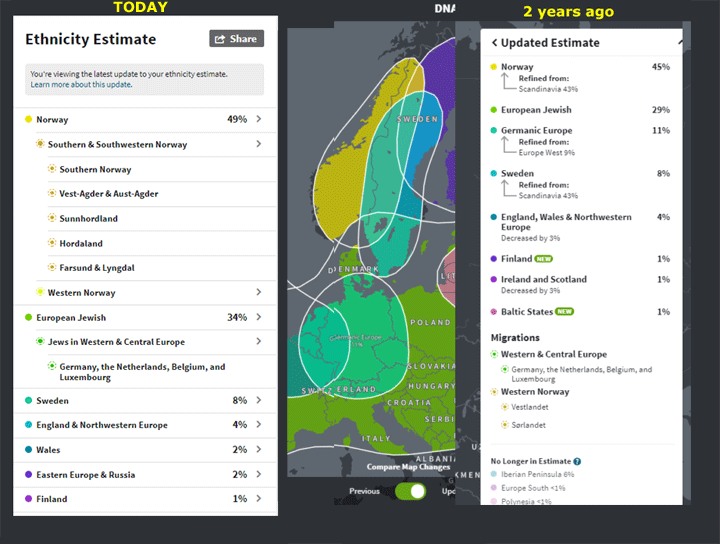
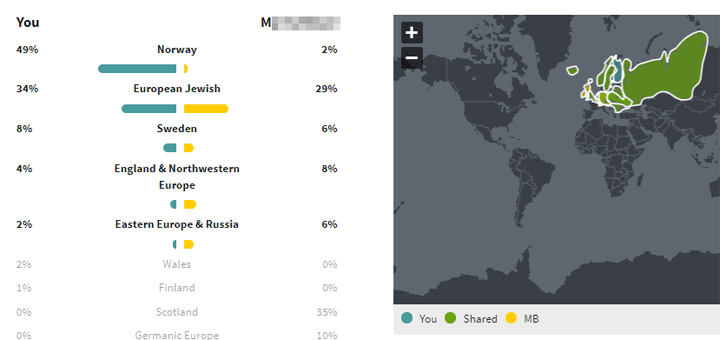
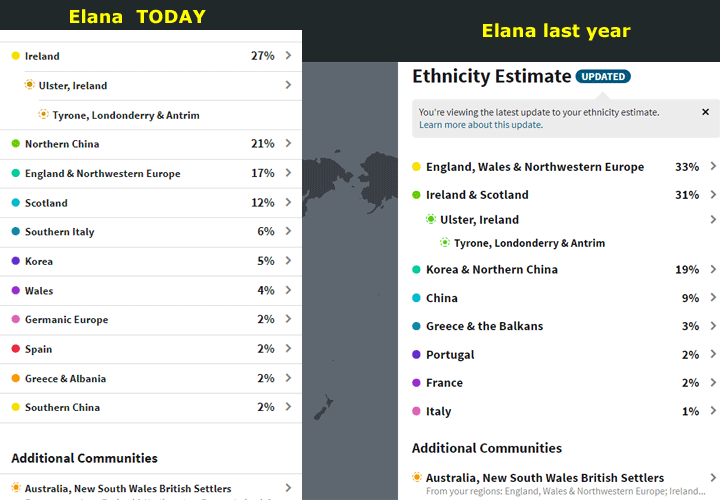
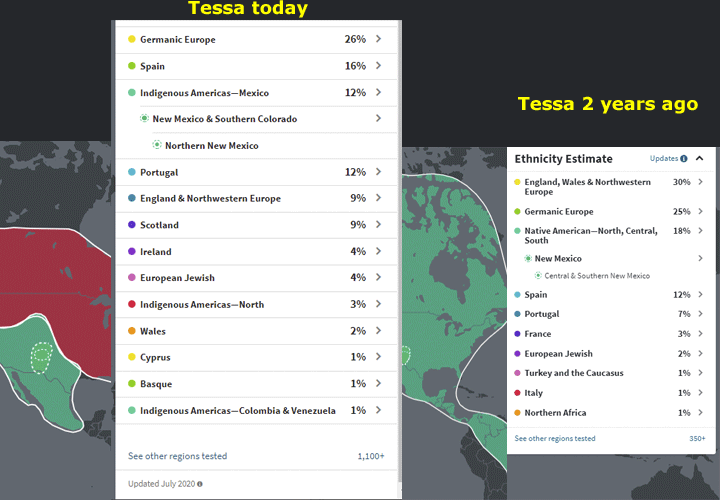
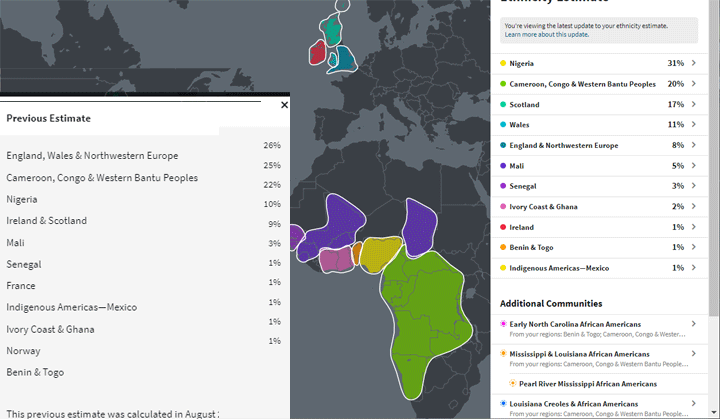
I have a German result similar to yours. I have a (transcript based) paper trail for ancestors back into the late 1600s in Wuerttemberg in southwest Germany. Each new Ancestry estimate places more of my origins in Sweden, where I am not aware of any ancestors, and less in that part of Europe, Durable bloodline from Viking invaders?
Much Swedish DNA came to Getmany in the 30 years war in the 1600s see https://en.m.wikipedia.org/wiki/Thirty_Years%27_War
Don’t know that the science is constantly improving as much as comparative proxy groups are constantly changing. The two are not synonymous.
“The science is constantly improving after all” – progress, in addition to methods, is also driven by data and we’re clearly seeing it here. Ancestry recently crossed 18 million users mark. I hope we’ll see even more of that in the future.
Ancestry’s statement to the financial press said they had sold 18 million tests. And they had 3 million active subscribers (that includes people who only have trees there).
And their ethnicity estimates are based on reference panels, NOT on subscribers. However, they do use subscriber data for their Genetic Communities, which I find useful – unfortunately slightly less so since their latest update. While they are updating reference panels from time to time, big areas are subdivided into smaller ones, so estimates should become more specific to region. Where they have no reference panel yet, a Genetic Community may provide a better estimate.
Interesting that Ancestry, FTDNA and MyHeritage are all updating around the time we are wondering what to put in people’s Christmas stockings this year – excellent timing.
Kitty,
Ditto on the German results. I have documented records going back to my maternal, 2nd great-grandfather’s parents that both immigrated to the United States from Baden-Württemberg and Rhineland-Palatinate. My great-grandmother even told me how she remembered getting frustrated at times as a child, because her relatives would all get together and speak German around her and she wouldn’t know what they were saying as she only spoke English! Prior to this recent update, I was estimated to be Germanic Europe 3%…my mother’s Germanic Europe estimate was 5%. Now, it has disappeared completely from both of our estimates.
My Norwegian estimate was only 1% prior, and has now vanished. However, my mother had 4% Sweden on her prior estimate and 0% Norway. Now, she has 1% Sweden and 15% Norway!
I got the new update as well. I am confused as with the old Ancestry, I was still different from My Heritage estimates (I uploaded my Ancestry DNA to My Heritage). Now all are very different. Not sure what to think.
This old post of mine discussed ethnicity at the different companies in 2016, and it explains alot. However it must be time for a new post on the subject!
http://blog.kittycooper.com/2016/04/ancestry-composition-comparisons-a-case-study/
I also have many posts under this tag
https://blog.kittycooper.com/tag/ancestry-compostion/
I was surprised at the new ethnicities results. Again.
When I first did my test I found I had a small amount of NA dna. This led me to ask my new found family on my birth father’s side about it. They are all enrolled Cherokee citizens with ancestors on the Dawes Rolls and paper trail all the way back to Georgia at the least.
My cousin and my aunt both showed the same NA ethnicity origin result as mine, although hers was higher naturally.
The next update last year wiped my entire NA ethnicity out, and added a sub of North Carolina Sandhills Settlers and North Arkansas and Middle Tennessee Settlers.
With this latest update I now have Indigenous Cuba. My aunt is Indigenous America-North, while my first cousin, my aunt’s son, has zero. My half brother (same father) has zero NA.
I am very confident of the lineage of my family. What I don’t comprehend is how my aunt can show Indigenous America-North while I show Indigenous Cuba. We descend from the very same people.
I also struggle with the numbers. Ancestry says they are using 44,000+ reference samples to determine their ethnicity results. If one uses just active subscribers that is a 1.4% sample rate. If one uses 18 million, it’s 2/10 of one percent.
If I am seeing different results with every update for just the NA ethnicity, how accurate are the other regions?
Trying to understand.